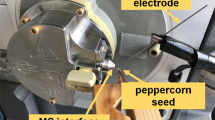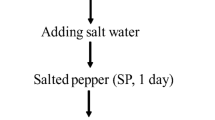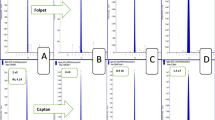Abstract
A method named imprint paper spray ionization mass spectrometry (imprint-PSI-MS) has been developed and employed for the determination of pungency of peppers. A pepper fruit was cut into a triangular shape, deposited onto a triangular paper, and compressed by a homemade press tool aiming to imprint and transfer the pepper constituents onto the paper surface. Subsequently, the triangular paper was submitted to conventional PSI-MS analysis. Twelve peppers were analyzed, ranging from highly pungent to lowly pungent taste. Pepper pungency values from the Scoville scale (in Scoville heat units, SHU) were compared with the ion intensities of the capsaicin and dihydrocapsaicin compounds obtained from the imprint-PSI-MS analysis, and a correlation coefficient of 0.97 was achieved. In addition, the ion intensities of a sugar compound were monitored in all peppers, and the results were compared with the Scoville scale. Low sugar ion intensities were detected in pungent peppers, while high ion intensities were achieved in low-pungent peppers, suggesting that the pepper pungency may be determined by inversely relating pungency to sugar contents. This work demonstrates the utility of the imprint-PSI-MS method to perform rapid qualitative analyses of peppers and estimate the pungency by monitoring the pepper metabolites.

Graphical abstract





Similar content being viewed by others
References
Hayes JE. Types of chemesthesis I. Pungency and burn: historical perspectives, word usage, and temporal characteristics. In: McDonald ST, Bolliet DA, Hayes JE, editors. Chemesthesis: chemical touch in food and eating. 1st ed. Hoboken: Wiley; 2016. p. 92–105.
Luo X-J, Peng J, Li Y-J. Recent advances in the study on capsaicinoids and capsinoids. Eur J Pharmacol. 2011;650:1–7.
Appendino G. Capsaicin and capsaicinoids. In: Fattorusso E, Taglialatela-Scafati O, editors. Modern alkaloids: structure, isolation, synthesis and biology. 1st ed. Weinheim: Wiley-VCH; 2008. p. 73–109.
Yang F, Zheng J. Understand spiciness: mechanism of TRPV1 channel activation by capsaicin. Protein Cell. 2017;8:169–77.
Hayman M, Kam PCA. Capsaicin: a review of its pharmacology and clinical applications. Curr Anaesth Crit Care. 2008;19:338–43.
Kaiser M, Higuera I, Goycoolea FM. Capsaicinoids: occurrence, chemistry, biosynthesis, and biological effects. In: Yahia EM, editor. Fruit and vegetable phytochemicals: chemistry and human health. 2nd ed. Hoboken: Wiley; 2018. p. 499–513.
Patowary P, Pathak MP, Zaman K, Raju PS, Chattopadhyay P. Research progress of capsaicin responses to various pharmacological challenges. Biomed Pharmacother. 2017;96:1501–12.
Scoville WL. Note on capsicums. J Am Pharm Assoc. 1912;1:453–4.
da Silva AA, Wiedemann LSM, da Veiga Junior VF. Food pungency: the evolution of methods for capsaicinoid analysis. Food Anal Methods. 2019;12:1327–45.
Cooks RG, Ouyang Z, Takats Z, Wiseman J. Ambient mass spectrometry. Science. 2006;311:1566–70.
Takáts Z, Wiseman JM, Gologan B, Cooks RG. Mass spectrometry sampling under ambient conditions with desorption electrospray ionization. Science. 2004;306:471–3.
Cody RB, Laramée JA, Durst HD. Versatile new ion source for the analysis of materials in open air under ambient conditions. Anal Chem. 2005;77:2297–302.
Feider CL, Krieger A, DeHoog RJ, Eberlin LS. Ambient ionization mass spectrometry: recent developments and applications. Anal Chem. 2019;91:4266–90.
Liu J, Wang H, Manicke NE, Lin J-M, Cooks RG, Ouyang Z. Development characterization and application of paper spray ionization. Anal Chem. 2010;82:2463–71.
Guo T, Yong W, Dong Y. Automatically high-throughput quantification by paper spray ionization mass spectrometry for multiple pesticides in wine. Food Anal Methods. 2019;12:1208–17.
Evard H, Kruve A, Lõhmus R, Leito I. Paper spray ionization mass spectrometry: study of a method for fast-screening analysis of pesticides in fruits and vegetables. J Food Compos Anal. 2015;41:221–5.
Basuri P, Sarkar D, Paramasivam G, Pradeep T. Detection of hydrocarbons by laser assisted paper spray ionization mass spectrometry (LAPSI MS). Anal Chem. 2018;90:4663–8.
Damon DE, Davis KM, Moreira CR, Capone P, Cruttenden R, Badu-Tawiah AK. Direct biofluid analysis using hydrophobic paper spray mass spectrometry. Anal Chem. 2016;88:1878–84.
Jett R, Skaggs C, Manicke N. Drug screening method development for paper spray coupled to a triple quadrupole mass spectrometer. Anal Methods. 2017;34:5037–43.
Chamberlain CA, Rubio VY, Garrett TJ. Strain-level differentiation of bacteria by paper spray ionization mass spectrometry. Anal Chem. 2019;91:4964–8.
Ma Q, Bai H, Li W, Wang C, Li X, Coos RG, et al. Direct identification of prohibited substances in cosmetics and foodstuffs using ambient ionization on a miniature mass spectrometry system. Anal Chim Acta. 2016;912:65–73.
Pereira I, Rodrigues MF, Chaves AR, Vaz BG. Molecularly imprinted polymer (MIP) membrane assisted direct spray ionization mass spectrometry for agrochemicals screening in foodstuffs. Talanta. 2018;178:507–14.
Moura ACM, Lago IN, Cardoso CF, dos Reis NA, Pereira I, Vaz BG. Rapid monitoring of pesticides in tomatoes (Solanum lycopersicum L.) during pre-harvest intervals by paper spray ionization mass spectrometry. Food Chem. 2020;310:125938.
Cody RB, Tamura J, Downard KM. Quantitation of anthocyanins in elderberry fruit extracts and nutraceutical formulations with paper spray ionization mass spectrometry. J Mass Spectrom. 2018;53:58–64.
Liu X, Gu Z, Guo Y, Liu J, Ma M, Chen B, et al. Rapid analysis of Aurantii fructus immaturus (Zhishi) using paper spray ionization mass spectrometry. J Pharm Biomed Anal. 2017;137:204–12.
Silva MR, Freitas LG, Souza AG, Araújo RLB, Lacerda ICA, Pereira HV, et al. Antioxidant activity and metabolomic analysis of cagaitas (Eugenia dysenterica) using paper spray mass spectrometry. J Braz Chem Soc. 2019;30:1034–44.
Sjovall P, Lausmaa J, Nygren H, Carlsson L, Malmberg P. Imaging of membrane lipids in single cells by imprint-imaging time-of-flight secondary ion mass spectrometry. Anal Chem. 2003;75:3429–34.
Vidova V, Novak P, Strohalm M, Pol J, Havlicek V, Volny M. Laser desorption-ionization of lipid transfers: tissue mass spectrometry imaging without MALDI matrix. Anal Chem. 2010;82:4994–7.
Muller T, Oradu S, Ifa DR, Cooks RG, Krautler B. Direct plant tissue analysis and imprint imaging by desorption electrospray ionization mass spectrometry. Anal Chem. 2011;83:5754–61.
Pereira I, de Carvalho TC, Romão W, Filgueiras PR, Laviola BG, Rodrigues CM, et al. Differentiation of toxic and non-toxic leaves of Jatropha curcas L. genotypes by leaf spray mass spectrometry. J Braz Chem Soc. 2017;28:1461–6.
Rosas J, Martínez JO, Alonso P, Miranda R, Velasco L, Rubio-Pérez L, et al. Alternative mass spectrometry techniques for the validation of the fragmentation pattern of capsaicin and dihydrocapsaicin. Rapid Commun Mass Spectrom. 2019;33:635–40.
Lee TA. A beginner’s guide to mass spectral interpretation. 1st ed. Chichester: Wiley; 1998.
Reilly CA, Ehlhardt WJ, Jackson DA, Kulanthaivel P, Mutlib AE, Espina RJ, et al. Metabolism of capsaicin by cytochrome P450 produces novel dehydrogenated metabolites and decreases cytotoxicity to lung and liver cells. Chem Res Toxicol. 2003;16:336–49.
Aza-González C, Núñez-Palenius HG, Ochoa-Alejo N. Molecular biology of capsaicinoid biosynthesis in chili pepper (Capsicum spp.). Plant Cell Rep. 2011;30:695–706.
Reifschneider FJB. Capsicum: pimentas e pimentões no Brasil. 1st ed. Brasília: Embrapa Hortaliças; 2000.
Sweat KG, Broatch J, Borror C, Hagan K, Cahill TM. Variability in capsaicinoid content and Scoville heat ratings of commercially grown Jalapeño, Habanero and Bhut Jolokia peppers. Food Chem. 2016;210:606–12.
Duelund L, Mouritsen OG. Contents of capsaicinoids in chillies grown in Denmark. Food Chem. 2017;221:913–8.
Wu T, Yuan X, Wu X, Tang Y, Lin H, Che Z, et al. Rapid determination of capsaicin and dihydrocapsaicin in fermented pepper paste by direct analysis in real time mass spectrometry. Food Anal Methods. 2019;12:32–40.
Zhang Q, Liu X, Li Z, Su Y, Guo Y. Rapid quantitative analysis with low matrix effects of capsaicin in various samples by thermal desorption carbon fiber ionization mass spectrometry. Anal Chim Acta. 2019;1048:115–22.
Jackson S, Swiner DJ, Capone PC, Badu-Tawiah AK. Thread spray mass spectrometry for direct analysis of capsaicinoids in pepper products. Anal Chim Acta. 2018;1023:81–8.
de Aguiar AC, Coutinho JP, Barbero GF, Godoy HT, Martínez J. Comparative study of capsaicinoid composition in capsicum peppers grown in Brazil. Int J Food Prop. 2016;19:1292–302.
Acknowledgments
The authors thank CAPES and SEDUC-Goiás for institutional support.
Funding
This study received financial support from CAPES and SEDUC-Goiás.
Author information
Authors and Affiliations
Corresponding author
Ethics declarations
Conflict of interest
The authors declare that they have no conflict of interest.
Additional information
Publisher’s note
Springer Nature remains neutral with regard to jurisdictional claims in published maps and institutional affiliations.
Electronic supplementary material
ESM 1
(PDF 192 kb).
Rights and permissions
About this article
Cite this article
Ramalho, R.R.F., da Silva, L.C., Maciel, L.I.L. et al. Directly transferring pepper constituents to triangular papers for pungency determination by paper spray ionization mass spectrometry. Anal Bioanal Chem 412, 5389–5396 (2020). https://doi.org/10.1007/s00216-020-02755-w
Received:
Revised:
Accepted:
Published:
Issue Date:
DOI: https://doi.org/10.1007/s00216-020-02755-w




